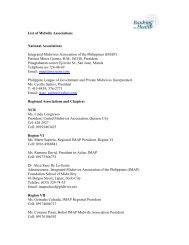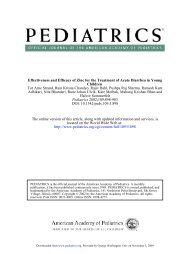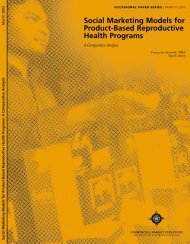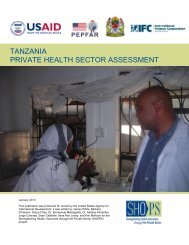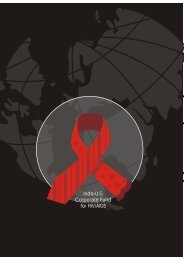Nigeria Private Sector Health Assessment - SHOPS project
Nigeria Private Sector Health Assessment - SHOPS project
Nigeria Private Sector Health Assessment - SHOPS project
You also want an ePaper? Increase the reach of your titles
YUMPU automatically turns print PDFs into web optimized ePapers that Google loves.
3. Background<br />
Economic Background: <strong>Nigeria</strong>’s economy is still dependent on oil, which contributes about threefourths<br />
of government revenues and about a third of gross domestic product. The oil sector, however,<br />
supplies little local employment, and the wealth earned by some people from this resource is in sharp<br />
contrast to the widespread poverty throughout the country. Gross national income per capita is still<br />
only around $400. During Sani Abacha’s regime in the 1990s the economy stagnated, but in the past<br />
three years there has been significant progress reducing the level of official debt; liberalizing trade;<br />
attracting foreign investment; and stimulating the private, non-oil sector. In 2005 the non-oil sector grew<br />
by 8 percent. The government increased capital requirements for banks leading to rapid consolidation<br />
in the banking sector and increasing the banks’ ability to lend to smaller enterprises. Corruption is still<br />
a major problem in the public and private sectors, but government efforts to increase transparency<br />
regarding its procurements and prosecute dishonest officials is helping to improve <strong>Nigeria</strong>’s image. Many<br />
more years of consistent progress on these fronts coupled with policies to address the inequities of<br />
wealth, however, will be necessary for the benefits of progress to be felt across a wider segment of the<br />
population.<br />
<strong>Health</strong> Background: Nowhere is the neglect during the Abacha regime more apparent than in the<br />
health sector. The mortality of children under 5 years old is estimated at 201 per 1,000 live births,<br />
maternal mortality is about 800 per 100,000 live births, total fertility is 5.7 children per woman,<br />
modern contraceptive methods have an 8 percent prevalence rate, adult HIV prevalence is estimated<br />
at 5 percent, and immunization rates are low with only 13 percent of 1 year olds receiving all of their<br />
recommended vaccinations (World Bank 2005).<br />
These outcomes suggest that the health care system is struggling. When one looks at service and<br />
consumption indicators, it is clear that neither the public- nor private-sector health systems are<br />
functioning effectively. According to World <strong>Health</strong> Organization (WHO) National <strong>Health</strong> Account<br />
analysis from 2003, consumers pay a high share of health expenditures—67 percent of health<br />
expenditures come from out of their pockets versus 26 percent from the government and 7 percent<br />
from the private sector (that is, private insurance and employers). Too often consumers forego<br />
treatment or pay for medical care from unskilled providers. No treatment is sought for 31 percent of<br />
children with a fever or who have symptoms of an upper respiratory infection (Demographic <strong>Health</strong><br />
Survey 2003). Twenty percent of children with diarrhea receive no treatment (Demographic <strong>Health</strong><br />
Survey 2003), and 66 percent of deliveries occur in the home with a skilled provider only attending<br />
35 percent of them. While this behavior is especially true for the poor, unassisted or using unskilled<br />
providers for deliveries occur in all income groups. As shown in Figure 1, even in the richer quintile of<br />
the population close to 50 percent of deliveries are occurring with unskilled providers.<br />
5



